Finance Report: Evaluating Funds, Costing, and Financial Analysis, XYZ
VerifiedAdded on 2020/09/17
|24
|7452
|240
Report
AI Summary
This finance report examines critical financial aspects relevant to the hospitality industry. It begins by exploring various funding sources available to businesses, differentiating between short-term and long-term capital, and evaluating the contributions of income generation. The report then delves into costing methods, including direct and indirect costs, and calculates gross profit percentages. It also covers methods for controlling cash and stock. Furthermore, the report analyzes budgetary control procedures and variance analysis, followed by an examination of trial balances and account adjustments. Financial ratios are calculated and analyzed to inform future strategies, and the report concludes with a discussion of cost classification, break-even point calculations, and the selection of appropriate financial proposals. The report utilizes examples from XYZ Pvt Ltd to illustrate key concepts.

FINANCE HI
Paraphrase This Document
Need a fresh take? Get an instant paraphrase of this document with our AI Paraphraser
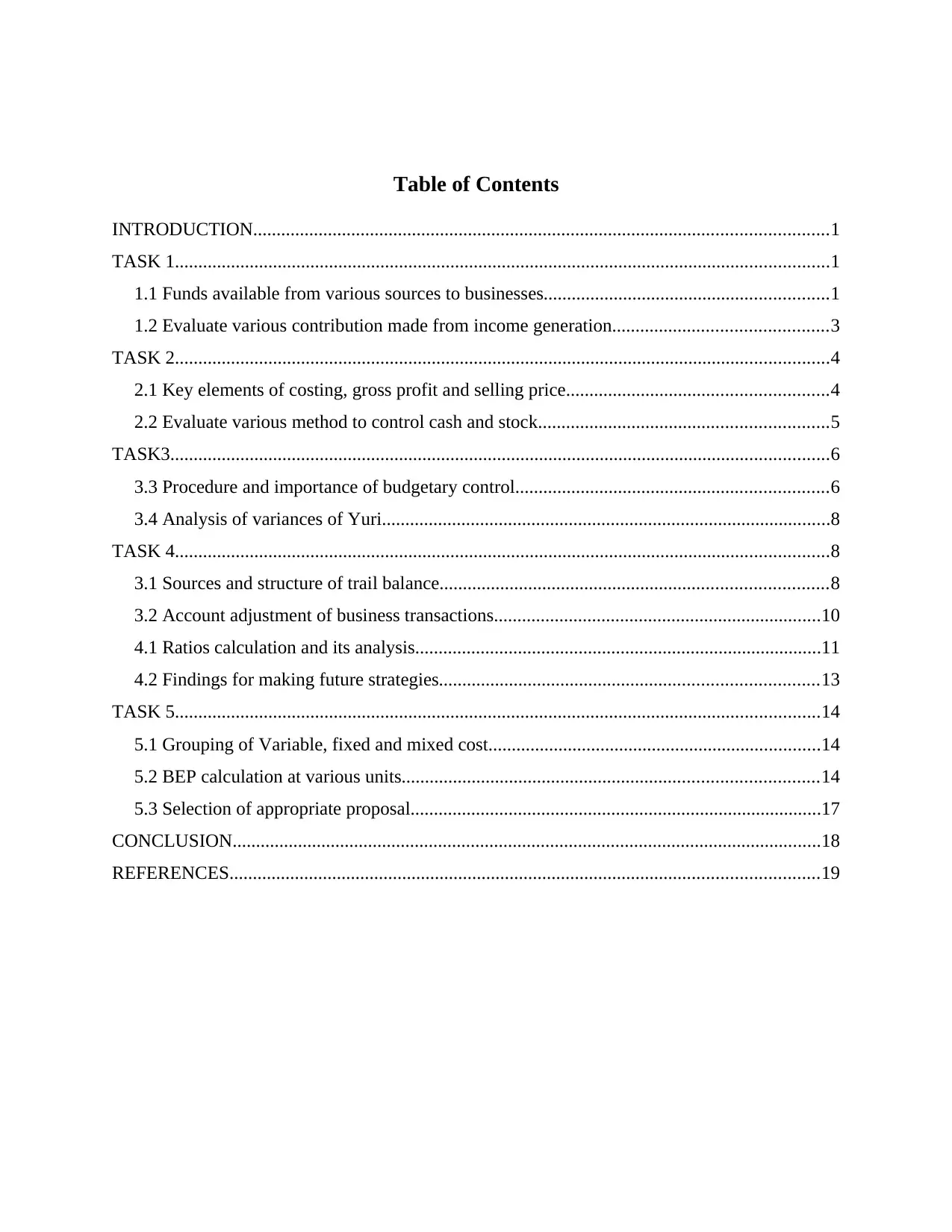
Table of Contents
INTRODUCTION...........................................................................................................................1
TASK 1............................................................................................................................................1
1.1 Funds available from various sources to businesses.............................................................1
1.2 Evaluate various contribution made from income generation..............................................3
TASK 2............................................................................................................................................4
2.1 Key elements of costing, gross profit and selling price........................................................4
2.2 Evaluate various method to control cash and stock..............................................................5
TASK3.............................................................................................................................................6
3.3 Procedure and importance of budgetary control...................................................................6
3.4 Analysis of variances of Yuri................................................................................................8
TASK 4............................................................................................................................................8
3.1 Sources and structure of trail balance...................................................................................8
3.2 Account adjustment of business transactions......................................................................10
4.1 Ratios calculation and its analysis.......................................................................................11
4.2 Findings for making future strategies.................................................................................13
TASK 5..........................................................................................................................................14
5.1 Grouping of Variable, fixed and mixed cost.......................................................................14
5.2 BEP calculation at various units.........................................................................................14
5.3 Selection of appropriate proposal........................................................................................17
CONCLUSION..............................................................................................................................18
REFERENCES..............................................................................................................................19
INTRODUCTION...........................................................................................................................1
TASK 1............................................................................................................................................1
1.1 Funds available from various sources to businesses.............................................................1
1.2 Evaluate various contribution made from income generation..............................................3
TASK 2............................................................................................................................................4
2.1 Key elements of costing, gross profit and selling price........................................................4
2.2 Evaluate various method to control cash and stock..............................................................5
TASK3.............................................................................................................................................6
3.3 Procedure and importance of budgetary control...................................................................6
3.4 Analysis of variances of Yuri................................................................................................8
TASK 4............................................................................................................................................8
3.1 Sources and structure of trail balance...................................................................................8
3.2 Account adjustment of business transactions......................................................................10
4.1 Ratios calculation and its analysis.......................................................................................11
4.2 Findings for making future strategies.................................................................................13
TASK 5..........................................................................................................................................14
5.1 Grouping of Variable, fixed and mixed cost.......................................................................14
5.2 BEP calculation at various units.........................................................................................14
5.3 Selection of appropriate proposal........................................................................................17
CONCLUSION..............................................................................................................................18
REFERENCES..............................................................................................................................19

⊘ This is a preview!⊘
Do you want full access?
Subscribe today to unlock all pages.

Trusted by 1+ million students worldwide
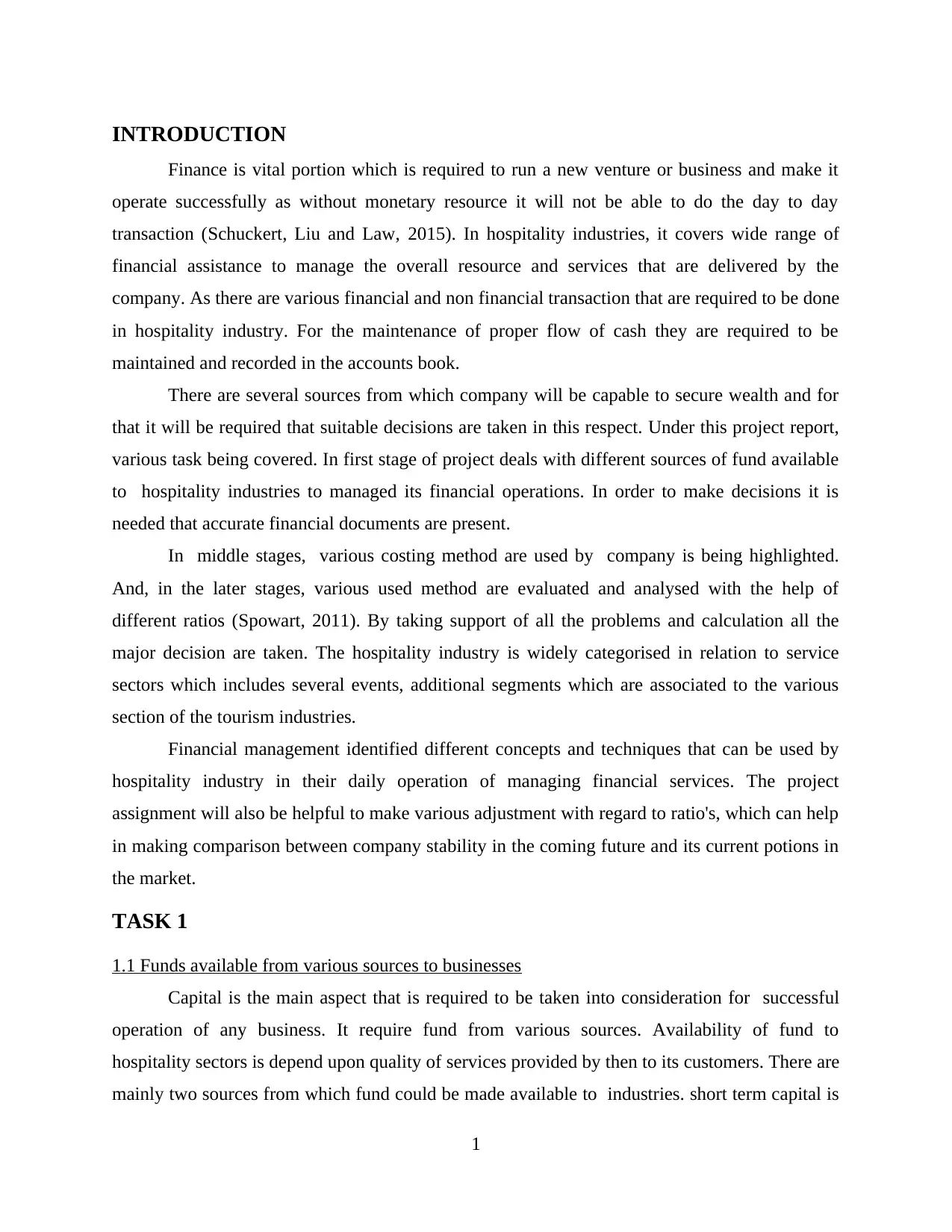
INTRODUCTION
Finance is vital portion which is required to run a new venture or business and make it
operate successfully as without monetary resource it will not be able to do the day to day
transaction (Schuckert, Liu and Law, 2015). In hospitality industries, it covers wide range of
financial assistance to manage the overall resource and services that are delivered by the
company. As there are various financial and non financial transaction that are required to be done
in hospitality industry. For the maintenance of proper flow of cash they are required to be
maintained and recorded in the accounts book.
There are several sources from which company will be capable to secure wealth and for
that it will be required that suitable decisions are taken in this respect. Under this project report,
various task being covered. In first stage of project deals with different sources of fund available
to hospitality industries to managed its financial operations. In order to make decisions it is
needed that accurate financial documents are present.
In middle stages, various costing method are used by company is being highlighted.
And, in the later stages, various used method are evaluated and analysed with the help of
different ratios (Spowart, 2011). By taking support of all the problems and calculation all the
major decision are taken. The hospitality industry is widely categorised in relation to service
sectors which includes several events, additional segments which are associated to the various
section of the tourism industries.
Financial management identified different concepts and techniques that can be used by
hospitality industry in their daily operation of managing financial services. The project
assignment will also be helpful to make various adjustment with regard to ratio's, which can help
in making comparison between company stability in the coming future and its current potions in
the market.
TASK 1
1.1 Funds available from various sources to businesses
Capital is the main aspect that is required to be taken into consideration for successful
operation of any business. It require fund from various sources. Availability of fund to
hospitality sectors is depend upon quality of services provided by then to its customers. There are
mainly two sources from which fund could be made available to industries. short term capital is
1
Finance is vital portion which is required to run a new venture or business and make it
operate successfully as without monetary resource it will not be able to do the day to day
transaction (Schuckert, Liu and Law, 2015). In hospitality industries, it covers wide range of
financial assistance to manage the overall resource and services that are delivered by the
company. As there are various financial and non financial transaction that are required to be done
in hospitality industry. For the maintenance of proper flow of cash they are required to be
maintained and recorded in the accounts book.
There are several sources from which company will be capable to secure wealth and for
that it will be required that suitable decisions are taken in this respect. Under this project report,
various task being covered. In first stage of project deals with different sources of fund available
to hospitality industries to managed its financial operations. In order to make decisions it is
needed that accurate financial documents are present.
In middle stages, various costing method are used by company is being highlighted.
And, in the later stages, various used method are evaluated and analysed with the help of
different ratios (Spowart, 2011). By taking support of all the problems and calculation all the
major decision are taken. The hospitality industry is widely categorised in relation to service
sectors which includes several events, additional segments which are associated to the various
section of the tourism industries.
Financial management identified different concepts and techniques that can be used by
hospitality industry in their daily operation of managing financial services. The project
assignment will also be helpful to make various adjustment with regard to ratio's, which can help
in making comparison between company stability in the coming future and its current potions in
the market.
TASK 1
1.1 Funds available from various sources to businesses
Capital is the main aspect that is required to be taken into consideration for successful
operation of any business. It require fund from various sources. Availability of fund to
hospitality sectors is depend upon quality of services provided by then to its customers. There are
mainly two sources from which fund could be made available to industries. short term capital is
1
Paraphrase This Document
Need a fresh take? Get an instant paraphrase of this document with our AI Paraphraser
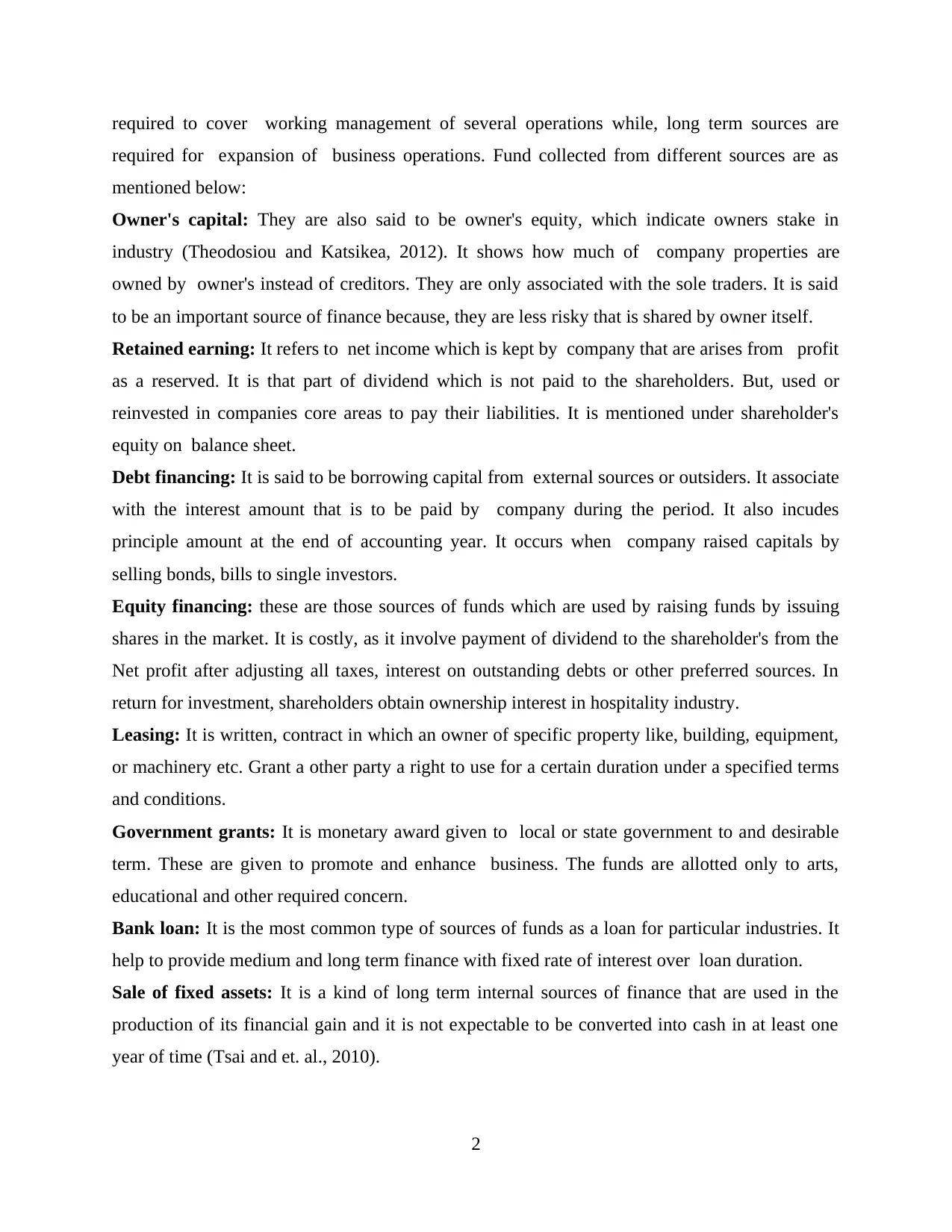
required to cover working management of several operations while, long term sources are
required for expansion of business operations. Fund collected from different sources are as
mentioned below:
Owner's capital: They are also said to be owner's equity, which indicate owners stake in
industry (Theodosiou and Katsikea, 2012). It shows how much of company properties are
owned by owner's instead of creditors. They are only associated with the sole traders. It is said
to be an important source of finance because, they are less risky that is shared by owner itself.
Retained earning: It refers to net income which is kept by company that are arises from profit
as a reserved. It is that part of dividend which is not paid to the shareholders. But, used or
reinvested in companies core areas to pay their liabilities. It is mentioned under shareholder's
equity on balance sheet.
Debt financing: It is said to be borrowing capital from external sources or outsiders. It associate
with the interest amount that is to be paid by company during the period. It also incudes
principle amount at the end of accounting year. It occurs when company raised capitals by
selling bonds, bills to single investors.
Equity financing: these are those sources of funds which are used by raising funds by issuing
shares in the market. It is costly, as it involve payment of dividend to the shareholder's from the
Net profit after adjusting all taxes, interest on outstanding debts or other preferred sources. In
return for investment, shareholders obtain ownership interest in hospitality industry.
Leasing: It is written, contract in which an owner of specific property like, building, equipment,
or machinery etc. Grant a other party a right to use for a certain duration under a specified terms
and conditions.
Government grants: It is monetary award given to local or state government to and desirable
term. These are given to promote and enhance business. The funds are allotted only to arts,
educational and other required concern.
Bank loan: It is the most common type of sources of funds as a loan for particular industries. It
help to provide medium and long term finance with fixed rate of interest over loan duration.
Sale of fixed assets: It is a kind of long term internal sources of finance that are used in the
production of its financial gain and it is not expectable to be converted into cash in at least one
year of time (Tsai and et. al., 2010).
2
required for expansion of business operations. Fund collected from different sources are as
mentioned below:
Owner's capital: They are also said to be owner's equity, which indicate owners stake in
industry (Theodosiou and Katsikea, 2012). It shows how much of company properties are
owned by owner's instead of creditors. They are only associated with the sole traders. It is said
to be an important source of finance because, they are less risky that is shared by owner itself.
Retained earning: It refers to net income which is kept by company that are arises from profit
as a reserved. It is that part of dividend which is not paid to the shareholders. But, used or
reinvested in companies core areas to pay their liabilities. It is mentioned under shareholder's
equity on balance sheet.
Debt financing: It is said to be borrowing capital from external sources or outsiders. It associate
with the interest amount that is to be paid by company during the period. It also incudes
principle amount at the end of accounting year. It occurs when company raised capitals by
selling bonds, bills to single investors.
Equity financing: these are those sources of funds which are used by raising funds by issuing
shares in the market. It is costly, as it involve payment of dividend to the shareholder's from the
Net profit after adjusting all taxes, interest on outstanding debts or other preferred sources. In
return for investment, shareholders obtain ownership interest in hospitality industry.
Leasing: It is written, contract in which an owner of specific property like, building, equipment,
or machinery etc. Grant a other party a right to use for a certain duration under a specified terms
and conditions.
Government grants: It is monetary award given to local or state government to and desirable
term. These are given to promote and enhance business. The funds are allotted only to arts,
educational and other required concern.
Bank loan: It is the most common type of sources of funds as a loan for particular industries. It
help to provide medium and long term finance with fixed rate of interest over loan duration.
Sale of fixed assets: It is a kind of long term internal sources of finance that are used in the
production of its financial gain and it is not expectable to be converted into cash in at least one
year of time (Tsai and et. al., 2010).
2

1.2 Evaluate various contribution made from income generation
XYZ Pvt Ltd, is tiny business unit which is handled by the sole proprietors. They are
eyeing to buy a building worth of £450,00. but company has two options which can be used by
them to purchased that building. The various sources of finance available to owner is internal and
external (Tse, 2012). Being a manager, of business I would planning to adopt that option which
is most economical and under the budget of company to buy that building. So , I would
preferred to go with internal sources because, it can easily be available with minimum risky.
There are five major internal sources of finance that can be used by the owners to purchased that
building:
Owner's investment which is said to be start up and additional capital which is brought by
the owner into its business.
Retained profit.
Sale of profit.
Sale of fixed assets or properties
Debt collection.
Depending on services and goods of company such as hospitality sectors, most of the profit is
collected from its core activities. So, if goods produce by the company is helpful in generating
funds from marketing of its core operations. From the above mentioned conditions owners have
the option to raised most of capital through financing of its activities through internal sources.
Capital investment appraisal is a situation in which organisation long time investments
are associated in purchasing building and replacement of machinery worth costing through
capitalization composition. Retained profit and income are mainly collected and analysed at
various level. On the basis of internal source it will easy to make appropriate decision for
increasing fund to a particular business concern (Zaitseva, 2013). There are certain advantages of
taking internal sources of finance:
Ease of cash flow problems that are arise from the internal sources of debt financing.
Venture capital are also used to raise large amount of fund and good way for expansion
if, there is perfect idea behind purchasing assets.
By issuing shares it will also help to be the part of owner's capital.
Control of situation are mostly in the hand's of sole traders about investing the fund with
limited assess.
3
XYZ Pvt Ltd, is tiny business unit which is handled by the sole proprietors. They are
eyeing to buy a building worth of £450,00. but company has two options which can be used by
them to purchased that building. The various sources of finance available to owner is internal and
external (Tse, 2012). Being a manager, of business I would planning to adopt that option which
is most economical and under the budget of company to buy that building. So , I would
preferred to go with internal sources because, it can easily be available with minimum risky.
There are five major internal sources of finance that can be used by the owners to purchased that
building:
Owner's investment which is said to be start up and additional capital which is brought by
the owner into its business.
Retained profit.
Sale of profit.
Sale of fixed assets or properties
Debt collection.
Depending on services and goods of company such as hospitality sectors, most of the profit is
collected from its core activities. So, if goods produce by the company is helpful in generating
funds from marketing of its core operations. From the above mentioned conditions owners have
the option to raised most of capital through financing of its activities through internal sources.
Capital investment appraisal is a situation in which organisation long time investments
are associated in purchasing building and replacement of machinery worth costing through
capitalization composition. Retained profit and income are mainly collected and analysed at
various level. On the basis of internal source it will easy to make appropriate decision for
increasing fund to a particular business concern (Zaitseva, 2013). There are certain advantages of
taking internal sources of finance:
Ease of cash flow problems that are arise from the internal sources of debt financing.
Venture capital are also used to raise large amount of fund and good way for expansion
if, there is perfect idea behind purchasing assets.
By issuing shares it will also help to be the part of owner's capital.
Control of situation are mostly in the hand's of sole traders about investing the fund with
limited assess.
3
⊘ This is a preview!⊘
Do you want full access?
Subscribe today to unlock all pages.

Trusted by 1+ million students worldwide

There are various methods with the help of which income will be generated and they are
provided below:
Increase in sales: This is most common method in which the amount of sales which will be made
by the business will be enhanced. By that the overall earnings of the business will be increased
and that will be used for further growth.
Commissions: In business there are various aspects which can be used to earn more income and
one of them is commission in which the extra charge is placed on the services which are
provided.
Sale of unused assets: There are various such assets which are lying idle in the company and are
not being used by them. They shall be sold so that the amount which will be derived can be used
in the business operations.
Controlling cost: In order to generate the income, it is not always necessary to increase the
earning as it can also be achieved by decreasing the amount spend which will affect the profits.
This will be because by reduction in cost, profits will be increased simultaneously.
TASK 2
2.1 Key elements of costing, gross profit and selling price
Hospitality industry could be analysed to follow as its separation of expenses that help
the activities to be in active manner (Sources of Finance, 2017). Hospitality business cost varies
from that of retail sector which is given in below:
Goods cost – It includes manufacturing price which is incurred directly on production
process. For instance unfinished goods, raw material to be converted into final products.
Working class cost – When labour work wages are given to them for the same. It is total
of wages paid to employee's, as well as cost of employee advantages and taxes that are
paid by an employer.
Operational expenses – Those expenses which a business incurred in any activities that
are not directly linked with production process. These include cost which is incurred
directly by entity. Different expenditure like obtaining new machinery, tools etc.
Marketing cost – It is the cost incurred for deducting various factory cost or other
overhead costs. In order to achieved high sales, cost will be obtain. It is mostly depend on
what are the selling method used by the company.
4
provided below:
Increase in sales: This is most common method in which the amount of sales which will be made
by the business will be enhanced. By that the overall earnings of the business will be increased
and that will be used for further growth.
Commissions: In business there are various aspects which can be used to earn more income and
one of them is commission in which the extra charge is placed on the services which are
provided.
Sale of unused assets: There are various such assets which are lying idle in the company and are
not being used by them. They shall be sold so that the amount which will be derived can be used
in the business operations.
Controlling cost: In order to generate the income, it is not always necessary to increase the
earning as it can also be achieved by decreasing the amount spend which will affect the profits.
This will be because by reduction in cost, profits will be increased simultaneously.
TASK 2
2.1 Key elements of costing, gross profit and selling price
Hospitality industry could be analysed to follow as its separation of expenses that help
the activities to be in active manner (Sources of Finance, 2017). Hospitality business cost varies
from that of retail sector which is given in below:
Goods cost – It includes manufacturing price which is incurred directly on production
process. For instance unfinished goods, raw material to be converted into final products.
Working class cost – When labour work wages are given to them for the same. It is total
of wages paid to employee's, as well as cost of employee advantages and taxes that are
paid by an employer.
Operational expenses – Those expenses which a business incurred in any activities that
are not directly linked with production process. These include cost which is incurred
directly by entity. Different expenditure like obtaining new machinery, tools etc.
Marketing cost – It is the cost incurred for deducting various factory cost or other
overhead costs. In order to achieved high sales, cost will be obtain. It is mostly depend on
what are the selling method used by the company.
4
Paraphrase This Document
Need a fresh take? Get an instant paraphrase of this document with our AI Paraphraser
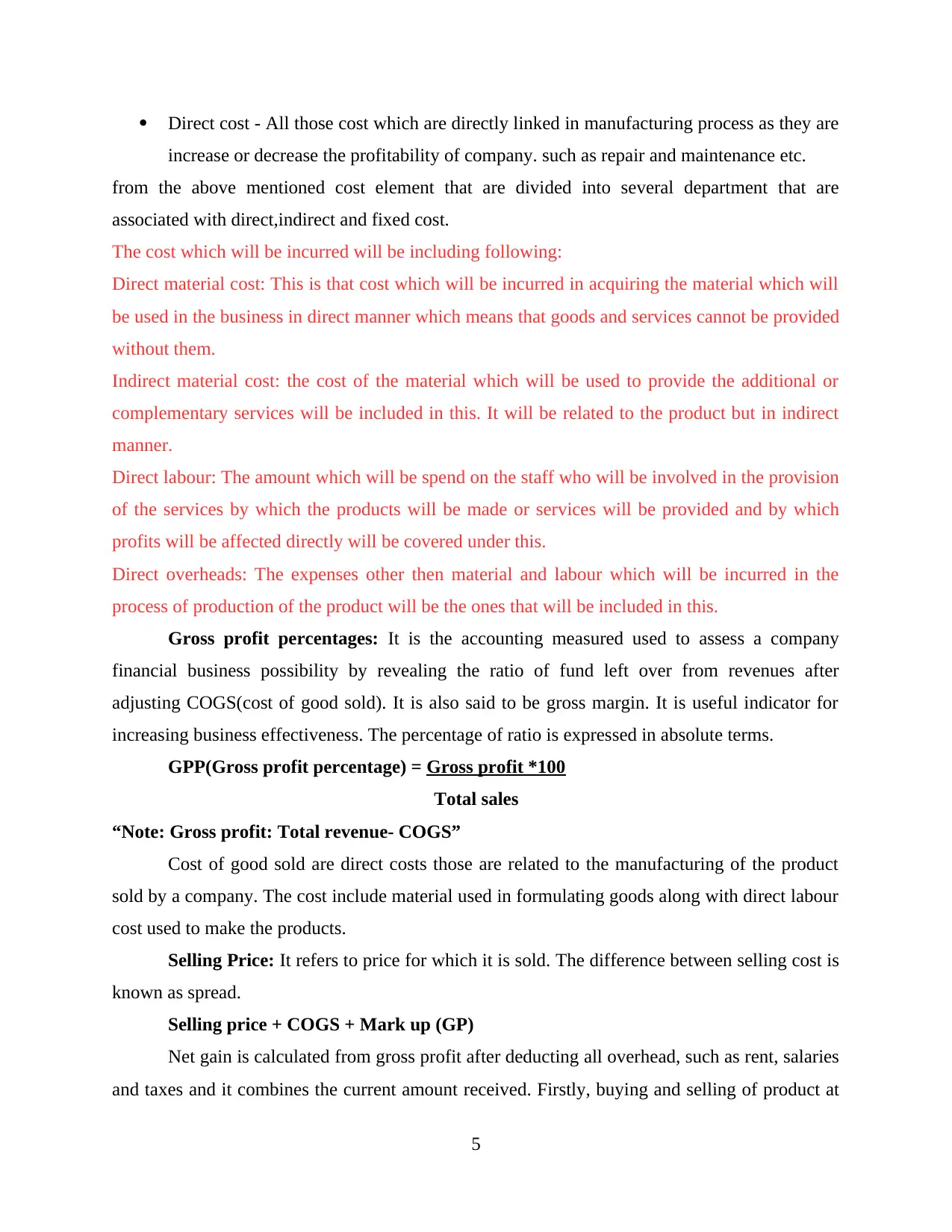
Direct cost - All those cost which are directly linked in manufacturing process as they are
increase or decrease the profitability of company. such as repair and maintenance etc.
from the above mentioned cost element that are divided into several department that are
associated with direct,indirect and fixed cost.
The cost which will be incurred will be including following:
Direct material cost: This is that cost which will be incurred in acquiring the material which will
be used in the business in direct manner which means that goods and services cannot be provided
without them.
Indirect material cost: the cost of the material which will be used to provide the additional or
complementary services will be included in this. It will be related to the product but in indirect
manner.
Direct labour: The amount which will be spend on the staff who will be involved in the provision
of the services by which the products will be made or services will be provided and by which
profits will be affected directly will be covered under this.
Direct overheads: The expenses other then material and labour which will be incurred in the
process of production of the product will be the ones that will be included in this.
Gross profit percentages: It is the accounting measured used to assess a company
financial business possibility by revealing the ratio of fund left over from revenues after
adjusting COGS(cost of good sold). It is also said to be gross margin. It is useful indicator for
increasing business effectiveness. The percentage of ratio is expressed in absolute terms.
GPP(Gross profit percentage) = Gross profit *100
Total sales
“Note: Gross profit: Total revenue- COGS”
Cost of good sold are direct costs those are related to the manufacturing of the product
sold by a company. The cost include material used in formulating goods along with direct labour
cost used to make the products.
Selling Price: It refers to price for which it is sold. The difference between selling cost is
known as spread.
Selling price + COGS + Mark up (GP)
Net gain is calculated from gross profit after deducting all overhead, such as rent, salaries
and taxes and it combines the current amount received. Firstly, buying and selling of product at
5
increase or decrease the profitability of company. such as repair and maintenance etc.
from the above mentioned cost element that are divided into several department that are
associated with direct,indirect and fixed cost.
The cost which will be incurred will be including following:
Direct material cost: This is that cost which will be incurred in acquiring the material which will
be used in the business in direct manner which means that goods and services cannot be provided
without them.
Indirect material cost: the cost of the material which will be used to provide the additional or
complementary services will be included in this. It will be related to the product but in indirect
manner.
Direct labour: The amount which will be spend on the staff who will be involved in the provision
of the services by which the products will be made or services will be provided and by which
profits will be affected directly will be covered under this.
Direct overheads: The expenses other then material and labour which will be incurred in the
process of production of the product will be the ones that will be included in this.
Gross profit percentages: It is the accounting measured used to assess a company
financial business possibility by revealing the ratio of fund left over from revenues after
adjusting COGS(cost of good sold). It is also said to be gross margin. It is useful indicator for
increasing business effectiveness. The percentage of ratio is expressed in absolute terms.
GPP(Gross profit percentage) = Gross profit *100
Total sales
“Note: Gross profit: Total revenue- COGS”
Cost of good sold are direct costs those are related to the manufacturing of the product
sold by a company. The cost include material used in formulating goods along with direct labour
cost used to make the products.
Selling Price: It refers to price for which it is sold. The difference between selling cost is
known as spread.
Selling price + COGS + Mark up (GP)
Net gain is calculated from gross profit after deducting all overhead, such as rent, salaries
and taxes and it combines the current amount received. Firstly, buying and selling of product at
5

account which is prepares to estimate GP, after that profit and loss statement is being prepared to
find out Net Profit.
2.2 Evaluate various method to control cash and stock
These are the major component of the working capital, is the cash is associated with
monetary transactions which includes trade receivables and payables. While, stock are the
company important part that can't be ignored (Variable, fixed and mixed (semi-variable) costs,
2017). But with respect to business and service, there are various level of properties depend upon
nature of industries. Moreover, hospitality industry is dealing with best service should be
delivered to customers.
For this, cash are utilized in effective manner with relation to the suppliers. On the other
ways, a distributor can be completed depend upon cash motivated. As for perfect coordination
and communication it is necessary to assure that there is no ideal cash, which control the excess
of cost investment and gain interest from operations.
Following are the various methods to control cash in the businesses:
Separation of duties: It means dividing the role or responsibilities fro bookkeeping,
deposits, auditing etc. it will protect the misuse of cash in financial transactions. The
responsibility can be shared between two or more people (Altinay, 2015).
Certain amount of packages is to be provide to the guest: By offering fixed amount of
packages can protect cash. These are most easy method which adopted by most of the
company.
Economical payment mode to customers: The customer all want is to make their payment
more easy and economical, as the result they don't want to avoid cheques because, cash is
not received at the same time.
Future forecasting: The most important ways to control cash is by setting up the future
target at regular duration.
Cash discount: whenever, customers make payment they are liable to get discount at their
purchase of goods and services.
Methods of controlling inventories:
Optimising Purchasing process: Under this, inventory is under effective control,
management should adopt purchasing process that align with actual sales background and
demand pattern.
6
find out Net Profit.
2.2 Evaluate various method to control cash and stock
These are the major component of the working capital, is the cash is associated with
monetary transactions which includes trade receivables and payables. While, stock are the
company important part that can't be ignored (Variable, fixed and mixed (semi-variable) costs,
2017). But with respect to business and service, there are various level of properties depend upon
nature of industries. Moreover, hospitality industry is dealing with best service should be
delivered to customers.
For this, cash are utilized in effective manner with relation to the suppliers. On the other
ways, a distributor can be completed depend upon cash motivated. As for perfect coordination
and communication it is necessary to assure that there is no ideal cash, which control the excess
of cost investment and gain interest from operations.
Following are the various methods to control cash in the businesses:
Separation of duties: It means dividing the role or responsibilities fro bookkeeping,
deposits, auditing etc. it will protect the misuse of cash in financial transactions. The
responsibility can be shared between two or more people (Altinay, 2015).
Certain amount of packages is to be provide to the guest: By offering fixed amount of
packages can protect cash. These are most easy method which adopted by most of the
company.
Economical payment mode to customers: The customer all want is to make their payment
more easy and economical, as the result they don't want to avoid cheques because, cash is
not received at the same time.
Future forecasting: The most important ways to control cash is by setting up the future
target at regular duration.
Cash discount: whenever, customers make payment they are liable to get discount at their
purchase of goods and services.
Methods of controlling inventories:
Optimising Purchasing process: Under this, inventory is under effective control,
management should adopt purchasing process that align with actual sales background and
demand pattern.
6
⊘ This is a preview!⊘
Do you want full access?
Subscribe today to unlock all pages.

Trusted by 1+ million students worldwide
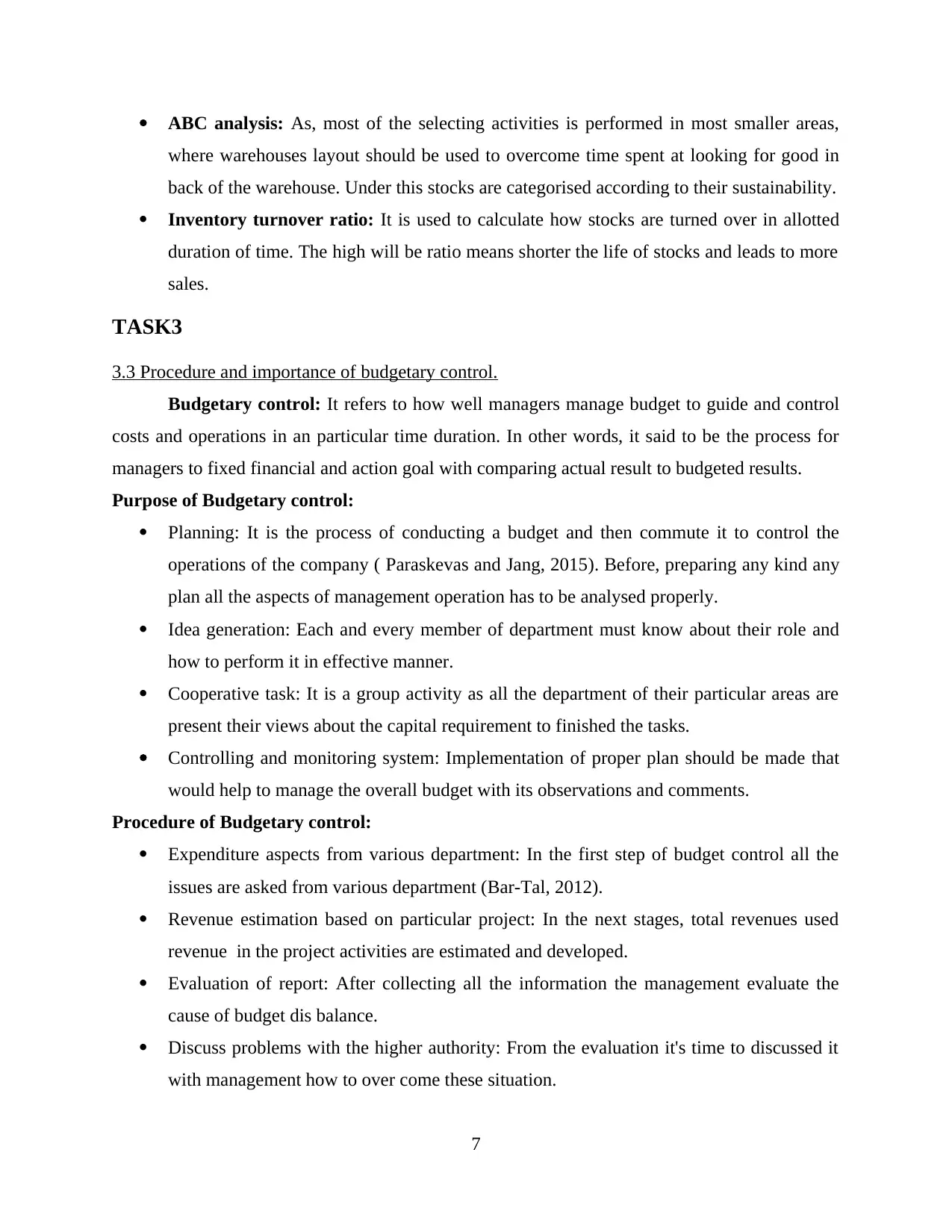
ABC analysis: As, most of the selecting activities is performed in most smaller areas,
where warehouses layout should be used to overcome time spent at looking for good in
back of the warehouse. Under this stocks are categorised according to their sustainability.
Inventory turnover ratio: It is used to calculate how stocks are turned over in allotted
duration of time. The high will be ratio means shorter the life of stocks and leads to more
sales.
TASK3
3.3 Procedure and importance of budgetary control.
Budgetary control: It refers to how well managers manage budget to guide and control
costs and operations in an particular time duration. In other words, it said to be the process for
managers to fixed financial and action goal with comparing actual result to budgeted results.
Purpose of Budgetary control:
Planning: It is the process of conducting a budget and then commute it to control the
operations of the company ( Paraskevas and Jang, 2015). Before, preparing any kind any
plan all the aspects of management operation has to be analysed properly.
Idea generation: Each and every member of department must know about their role and
how to perform it in effective manner.
Cooperative task: It is a group activity as all the department of their particular areas are
present their views about the capital requirement to finished the tasks.
Controlling and monitoring system: Implementation of proper plan should be made that
would help to manage the overall budget with its observations and comments.
Procedure of Budgetary control:
Expenditure aspects from various department: In the first step of budget control all the
issues are asked from various department (Bar-Tal, 2012).
Revenue estimation based on particular project: In the next stages, total revenues used
revenue in the project activities are estimated and developed.
Evaluation of report: After collecting all the information the management evaluate the
cause of budget dis balance.
Discuss problems with the higher authority: From the evaluation it's time to discussed it
with management how to over come these situation.
7
where warehouses layout should be used to overcome time spent at looking for good in
back of the warehouse. Under this stocks are categorised according to their sustainability.
Inventory turnover ratio: It is used to calculate how stocks are turned over in allotted
duration of time. The high will be ratio means shorter the life of stocks and leads to more
sales.
TASK3
3.3 Procedure and importance of budgetary control.
Budgetary control: It refers to how well managers manage budget to guide and control
costs and operations in an particular time duration. In other words, it said to be the process for
managers to fixed financial and action goal with comparing actual result to budgeted results.
Purpose of Budgetary control:
Planning: It is the process of conducting a budget and then commute it to control the
operations of the company ( Paraskevas and Jang, 2015). Before, preparing any kind any
plan all the aspects of management operation has to be analysed properly.
Idea generation: Each and every member of department must know about their role and
how to perform it in effective manner.
Cooperative task: It is a group activity as all the department of their particular areas are
present their views about the capital requirement to finished the tasks.
Controlling and monitoring system: Implementation of proper plan should be made that
would help to manage the overall budget with its observations and comments.
Procedure of Budgetary control:
Expenditure aspects from various department: In the first step of budget control all the
issues are asked from various department (Bar-Tal, 2012).
Revenue estimation based on particular project: In the next stages, total revenues used
revenue in the project activities are estimated and developed.
Evaluation of report: After collecting all the information the management evaluate the
cause of budget dis balance.
Discuss problems with the higher authority: From the evaluation it's time to discussed it
with management how to over come these situation.
7
Paraphrase This Document
Need a fresh take? Get an instant paraphrase of this document with our AI Paraphraser
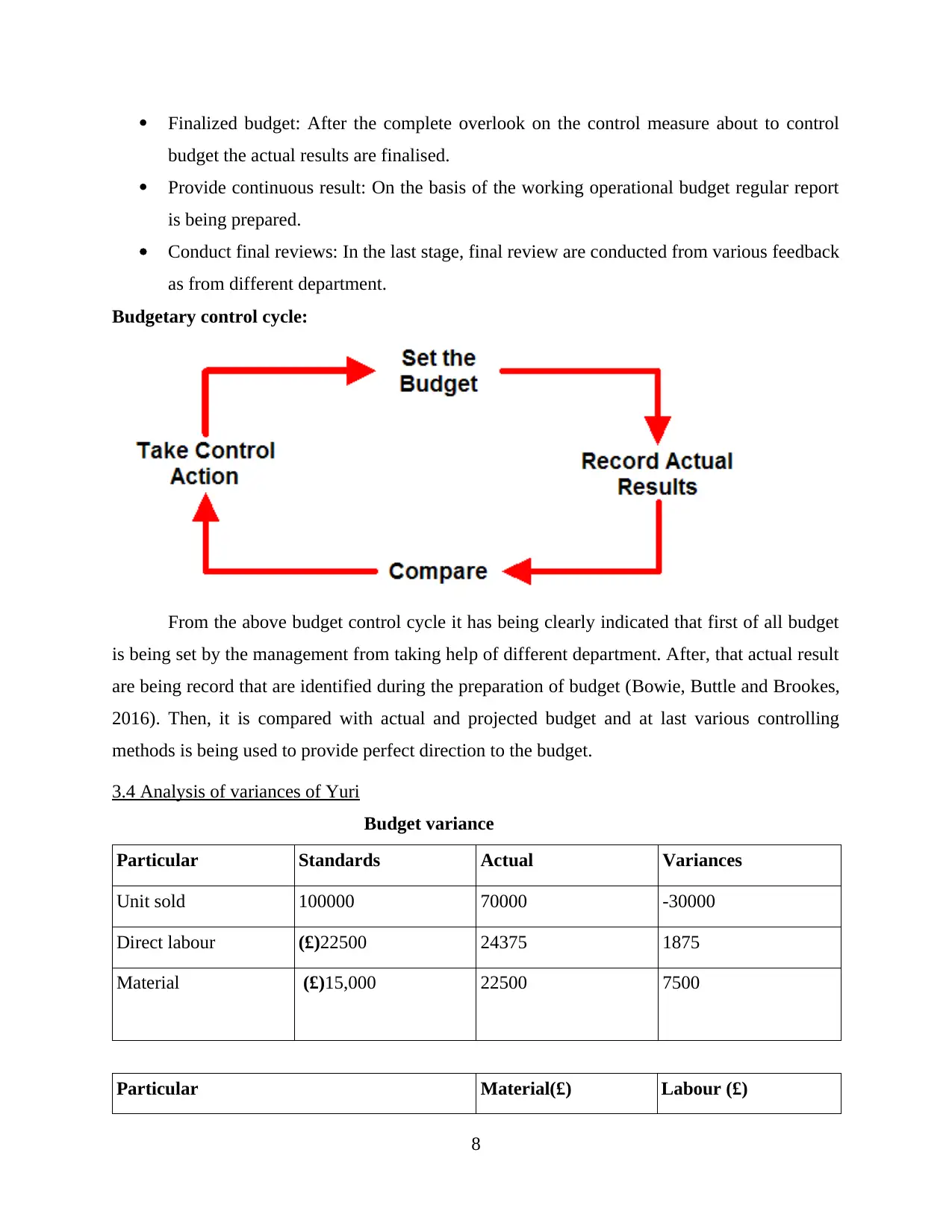
Finalized budget: After the complete overlook on the control measure about to control
budget the actual results are finalised.
Provide continuous result: On the basis of the working operational budget regular report
is being prepared.
Conduct final reviews: In the last stage, final review are conducted from various feedback
as from different department.
Budgetary control cycle:
From the above budget control cycle it has being clearly indicated that first of all budget
is being set by the management from taking help of different department. After, that actual result
are being record that are identified during the preparation of budget (Bowie, Buttle and Brookes,
2016). Then, it is compared with actual and projected budget and at last various controlling
methods is being used to provide perfect direction to the budget.
3.4 Analysis of variances of Yuri
Budget variance
Particular Standards Actual Variances
Unit sold 100000 70000 -30000
Direct labour (£)22500 24375 1875
Material (£)15,000 22500 7500
Particular Material(£) Labour (£)
8
budget the actual results are finalised.
Provide continuous result: On the basis of the working operational budget regular report
is being prepared.
Conduct final reviews: In the last stage, final review are conducted from various feedback
as from different department.
Budgetary control cycle:
From the above budget control cycle it has being clearly indicated that first of all budget
is being set by the management from taking help of different department. After, that actual result
are being record that are identified during the preparation of budget (Bowie, Buttle and Brookes,
2016). Then, it is compared with actual and projected budget and at last various controlling
methods is being used to provide perfect direction to the budget.
3.4 Analysis of variances of Yuri
Budget variance
Particular Standards Actual Variances
Unit sold 100000 70000 -30000
Direct labour (£)22500 24375 1875
Material (£)15,000 22500 7500
Particular Material(£) Labour (£)
8
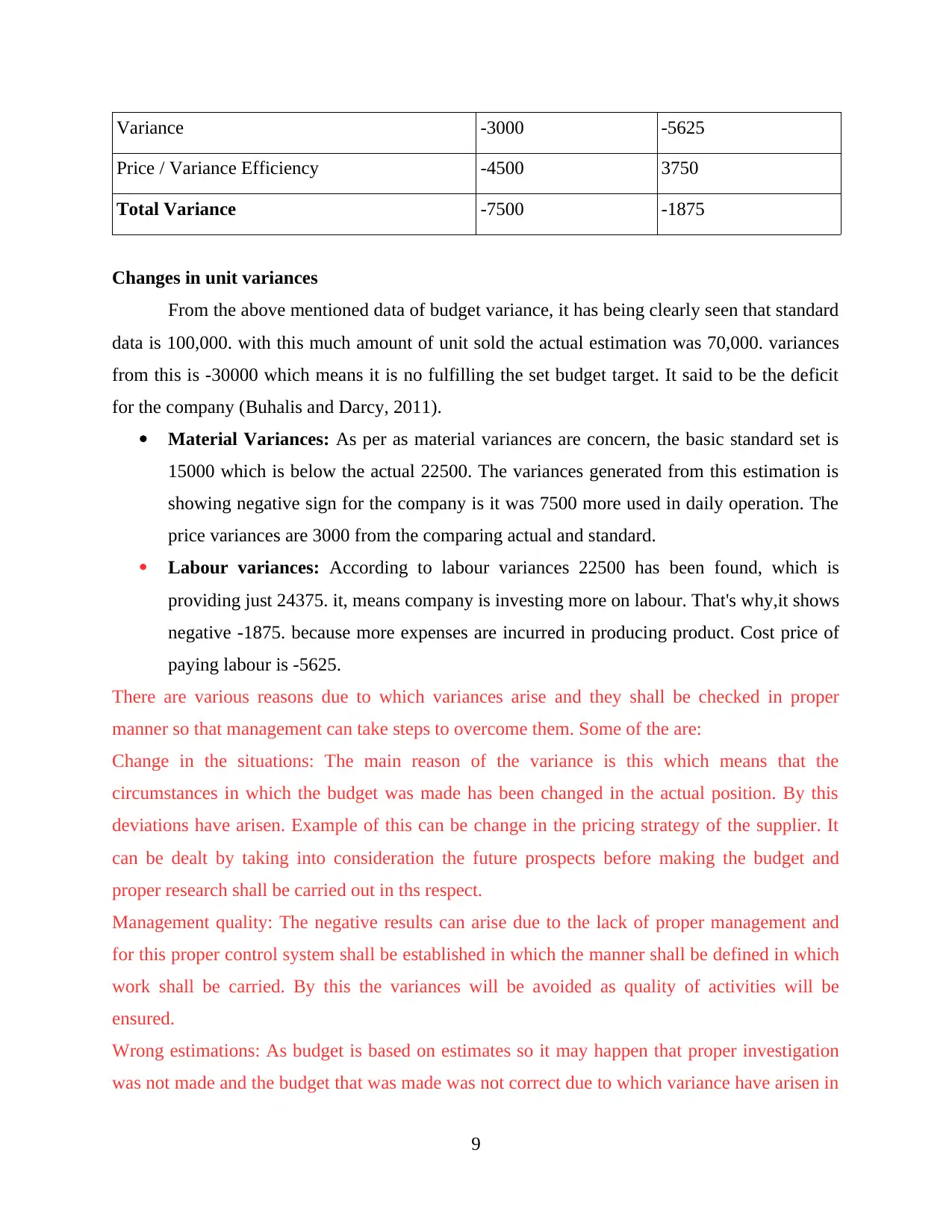
Variance -3000 -5625
Price / Variance Efficiency -4500 3750
Total Variance -7500 -1875
Changes in unit variances
From the above mentioned data of budget variance, it has being clearly seen that standard
data is 100,000. with this much amount of unit sold the actual estimation was 70,000. variances
from this is -30000 which means it is no fulfilling the set budget target. It said to be the deficit
for the company (Buhalis and Darcy, 2011).
Material Variances: As per as material variances are concern, the basic standard set is
15000 which is below the actual 22500. The variances generated from this estimation is
showing negative sign for the company is it was 7500 more used in daily operation. The
price variances are 3000 from the comparing actual and standard.
Labour variances: According to labour variances 22500 has been found, which is
providing just 24375. it, means company is investing more on labour. That's why,it shows
negative -1875. because more expenses are incurred in producing product. Cost price of
paying labour is -5625.
There are various reasons due to which variances arise and they shall be checked in proper
manner so that management can take steps to overcome them. Some of the are:
Change in the situations: The main reason of the variance is this which means that the
circumstances in which the budget was made has been changed in the actual position. By this
deviations have arisen. Example of this can be change in the pricing strategy of the supplier. It
can be dealt by taking into consideration the future prospects before making the budget and
proper research shall be carried out in ths respect.
Management quality: The negative results can arise due to the lack of proper management and
for this proper control system shall be established in which the manner shall be defined in which
work shall be carried. By this the variances will be avoided as quality of activities will be
ensured.
Wrong estimations: As budget is based on estimates so it may happen that proper investigation
was not made and the budget that was made was not correct due to which variance have arisen in
9
Price / Variance Efficiency -4500 3750
Total Variance -7500 -1875
Changes in unit variances
From the above mentioned data of budget variance, it has being clearly seen that standard
data is 100,000. with this much amount of unit sold the actual estimation was 70,000. variances
from this is -30000 which means it is no fulfilling the set budget target. It said to be the deficit
for the company (Buhalis and Darcy, 2011).
Material Variances: As per as material variances are concern, the basic standard set is
15000 which is below the actual 22500. The variances generated from this estimation is
showing negative sign for the company is it was 7500 more used in daily operation. The
price variances are 3000 from the comparing actual and standard.
Labour variances: According to labour variances 22500 has been found, which is
providing just 24375. it, means company is investing more on labour. That's why,it shows
negative -1875. because more expenses are incurred in producing product. Cost price of
paying labour is -5625.
There are various reasons due to which variances arise and they shall be checked in proper
manner so that management can take steps to overcome them. Some of the are:
Change in the situations: The main reason of the variance is this which means that the
circumstances in which the budget was made has been changed in the actual position. By this
deviations have arisen. Example of this can be change in the pricing strategy of the supplier. It
can be dealt by taking into consideration the future prospects before making the budget and
proper research shall be carried out in ths respect.
Management quality: The negative results can arise due to the lack of proper management and
for this proper control system shall be established in which the manner shall be defined in which
work shall be carried. By this the variances will be avoided as quality of activities will be
ensured.
Wrong estimations: As budget is based on estimates so it may happen that proper investigation
was not made and the budget that was made was not correct due to which variance have arisen in
9
⊘ This is a preview!⊘
Do you want full access?
Subscribe today to unlock all pages.

Trusted by 1+ million students worldwide
1 out of 24
Related Documents
Your All-in-One AI-Powered Toolkit for Academic Success.
+13062052269
info@desklib.com
Available 24*7 on WhatsApp / Email
![[object Object]](/_next/static/media/star-bottom.7253800d.svg)
Unlock your academic potential
Copyright © 2020–2025 A2Z Services. All Rights Reserved. Developed and managed by ZUCOL.





